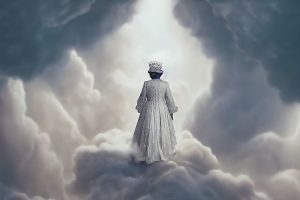Ministry of propaganda dictates what to teach about the death of the Queen
Updated September 2022-09-23
OOPS! The York Region DSB (YRDSB) stepped in a political puddle just after the death of Queen Elizabeth. The board’s Communication Director Licinio Miguelo told me that board staff wanted to ease back on tributes because, at about 124 000 students, there could be a wide range of reactions to her passing. For some, with family backgrounds from former British colonies or First Nations, giving too much air time to the pomp and ceremony of the past week and a half might just be too much. With a school board as diverse as York Region’s it made sense to lower the temperature a bit and leave reactions to parents and families to deal with it as they saw fit. Schools lowered their flags and the YRDSB sent around a “tip sheet” to help local educators answer questions that might come from students and parents.
That just wasn’t going to cut it for Stephen Lecce’s command and control Ministry of Education. Deputy Minister, Nancy Naylor sent out a memo to all directors of education last week, reminding them who they really work for. No variations – schools were “strongly” encouraged to mark “Her Majesty’s legacy of service to the people of Canada and across the Commonwealth” yesterday at about 1:00 p.m. So far, this was typical micro-management from a government that wants to have the appearance of boards without the bother of them actually directing local education.

But what really bites, is the next diktat of the memo: “Schools should ensure that the day’s activities include learning about the many contributions the Queen made to our province, country, and Commonwealth, and the Accession of King Charles III to the Throne.” Take off your caps and tug your forelocks. Forget anything that might have been nodded to about equity and diversity. Forget any ideas you might have about being sensitive to the reactions of Indigenous families whose members spent time in residential schools – and no apology from the Queen. Ignore what British forces did in her name, to crush the Mau Mau rebellion in Kenya or to side with a brutal Nigerian dictatorship crushing the secession of Biafra during which about 1 million members of the Igbo tribe were slaughtered or starved to death.
Just say nice things about her and ignore the inconvenience of history. Jodie Williams knows about this. She is co-chair of the First Nations Metis and Inuit Education Association Ontario (FNMIEAO) and told me that the result of the Ministry memo “is to deny the fact that the Queen, as head of the monarchy had anything to do with the horrors of colonial violence that has taken place over the centuries.” As far as she is concerned making school boards celebrate her passing “is just continuing the violence” with directives like this that sanitize history.
Ms. Williams has plenty of experience with official records edited to make colonizers look like they deserved what they took. It’s only recently that most of us learned of beatings, sexual assaults and death of children in Canadian residential  schools. In 2018, contrary to education recommendations from Canada’s Truth and Reconciliation Commission, the newly ensconced Tories suddenly ended work on an Indigenous curriculum. Nothing happened for a couple of years, but last summer Ms. Williams advised the Ministry on Indigenous knowledge for a revamp of the provincial science and technology curriculum. In March, just three weeks before it was to be released, Stephen Lecce’s office ordered the deletion of language that would have educators examine “scientific and knowledge systems and perspectives of various cultures.” To get a little more specific, another section was crossed out that called on kids to “explore real world issues by connecting Indigenous sciences and technologies and Western science and technology using ways of knowing such as the Two-Eyed Seeing approach.”1 The same thing happened last year when the Ministry decided to remove references to racism and colonialism from the new math curriculum. Ministry thinking must be: just toss aside knowledge from the cultures of kids going to Ontario schools if it doesn’t pass political muster or might not please Tory supporters. After all, the people asked to advise on the curriculum are dispensable window-dressing put there to give the appearance of consultation. It’s easy to see why Ms. Williams thinks removal of such knowledge “reinforces colonialism.”
schools. In 2018, contrary to education recommendations from Canada’s Truth and Reconciliation Commission, the newly ensconced Tories suddenly ended work on an Indigenous curriculum. Nothing happened for a couple of years, but last summer Ms. Williams advised the Ministry on Indigenous knowledge for a revamp of the provincial science and technology curriculum. In March, just three weeks before it was to be released, Stephen Lecce’s office ordered the deletion of language that would have educators examine “scientific and knowledge systems and perspectives of various cultures.” To get a little more specific, another section was crossed out that called on kids to “explore real world issues by connecting Indigenous sciences and technologies and Western science and technology using ways of knowing such as the Two-Eyed Seeing approach.”1 The same thing happened last year when the Ministry decided to remove references to racism and colonialism from the new math curriculum. Ministry thinking must be: just toss aside knowledge from the cultures of kids going to Ontario schools if it doesn’t pass political muster or might not please Tory supporters. After all, the people asked to advise on the curriculum are dispensable window-dressing put there to give the appearance of consultation. It’s easy to see why Ms. Williams thinks removal of such knowledge “reinforces colonialism.”
It’s no surprise, really, that the Ministry would think references to different kinds knowledge is just so much fluff. Grace Lee, spokesperson for Mr. Lecce told the Globe and Mail when the sanitized curriculum was brought out: “we remain focused on ensuring that Ontario’s students excel at the foundations of math, science and reading so they can pursue good paying jobs.”2 That’s what Doug Ford said before the election during the leaders’ debate. The Ministry of Education is there to churn out workers and consumers. Informed, aware citizens, with an appreciation of other cultures, arts, the environment? Mmmmmnn…not so much. At a time when democracy is under increasing threat from ignorance and lack of interest, who needs a well-educated electorate?
That’s what the Ministry say-nice-things-about-the-Queen memo reinforces in no uncertain terms. It makes it clear to educators: their job is not to tell the full story – it’s to disseminate propaganda. This is its most ominous feature. The Ministry here, is acting in opposition to education, preferring to put its own slant on information that gets out to students. Now that propaganda door has been opened, I can imagine other memos: Discuss the many benefits of Highway 413; Ensure that students understand the merits of well-off people paying fewer taxes; Teach how the strong mayor system really is good government. It goes on. The bottom-line is that the Ministry of Education has no business undermining educators’ autonomy by telling them to teach students about the Queen’s positive contributions whatever they might be, despite awful acts done in her name.
Propaganda and the Ministry walk hand in hand and Minister Lecce, himself, is no amateur at spreading misinformation. Just before school started, he stirred the negotiations pot to get families riled up against education workers who have had their wage increases capped to 1% per year since 2019. With hand over heart Mr. Lecce wrote in a column for the Toronto Sun:
“Our commitment is clear: we will stand up for your child’s right to learn, from September right to June. Nothing is more important.
Education unions need to get on board with keeping kids in class without disruption, instead of strikes and withdrawal of services. These are not subtle threats. Language like, “if we do not get our 52% wage hike demand, then expect strikes” is what some would call ‘schoolyard bullying.’”
Well, that’s not really true. Spin is more important than students’ right to learn. And truth takes a back seat to spin, since the 52% wage demand he frets about – likely aimed at CUPE – doesn’t exist; this misinformation appears to have slipped by fact checkers at The Sun. Many, many emails and calls to Ministry media people went unreturned, so there is no clue as to what part of Mr. Lecce’s brain produced that deception along with the claim by another Ministry spokesperson Caitlin Clark, that the non-existent wage demand “would cost taxpayers $21.8 billion over the proposed three years.” Truth is not in great supply at the Ministry of Education.
Note: Since this article was published, I got a response to my questions from Romina Di Pasquale at the Ministry’s labour branch who attempted to explain the wage demand: “the government has forecasted that the CUPE/OSBCU proposal amounts to a salary and related compensation increase of 52% over their proposed three-year term.” How that forecast came about is still a question. And it’s worth noting that CUPE members like other civil servants have had their wages capped at 1% per year since 2019 under Bill 124. The union is asking for a 31.7% increase over 3 years – not 52%. School support staff are only now beginning to hold a strike vote. So Mr. Lecce’s charge of “schoolyard bullying” was baseless.
It’s time to understand that education of future citizens is the last thing the Ford government wants. It’s too busy cutting costs, privatizing and disseminating nonsense passed as truth. But it’s that last bit about propaganda that is most abhorrent – telling school boards what they need to say about the passing of the Queen and determining the kinds of facts that may be shared. Educators who ignored that Ministry order and discussed real history, deserve our thanks. They did what self-respecting educators must. To borrow words again from Jodie Williams: “ if we’re going to teach legacy, we’re going to teach all the legacy.”

Here are some references that might help educators address the full legacy:
Queen Elizabeth II’s Death Is a Chance to Examine the Present-Day Effects of Britain’s Colonial Past
Time
For many of us from the ‘colonies,’ the death of Elizabeth II signifies in very particular ways that she was the symbol of an empire built on genocide, slavery, violence, extraction, and brutality, the legacies of which continue in our present day,” says Anna Arabindan-Kesson, a professor of Black diasporic art at Princeton University. “She was not only a symbol, she was complicit in this empire.”
Not everyone mourns the queen. For many, she can’t be separated from colonial rule
NPR
Moses Ochonu, a professor of African studies at Vanderbilt University, told NPR the queen’s death brought attention to “unfinished colonial business.”
“There is a sense in which Britain has never fully accounted for its crimes,” Ochonu said.
Buried for 50 years: Britain’s shameful role in the Biafran war
The Guardian
But there is one truly disgusting policy practised by our officialdom during the lifetime of anyone over 50, and one word will suffice: Biafra.
This referred to the civil war in Nigeria that ended 50 years ago this month. It stemmed from the decision of the people of the eastern region of that already riot-racked country to strike for independence as the Republic of Biafra.
Queen Elizabeth II’s legacy: Instead of mourning, many are questioning
Global News
So, while a wave of sadness has undoubtedly swept the globe, it’s clear that the queen was not universally adored. She’s been criticized for actively participating in and holding up an institution that resulted in the loss of culture, land and lives in Canada, Africa, the Caribbean and Asia, among other places.
Others, however, point out that despite being a monarch, the queen was not Prime Minister and did not hold the power to make decisions regarding the administration of the country. Some argue that she was a prisoner of circumstance and was following the traditional duties and values that had been established for members of the Royal Family for centuries.
The queen could have redressed Britain’s colonial sins. She didn’t.
Politico
Quote No matter how ceremonial the monarchy’s role might be in Britain, it has a separate, more malevolent legacy for the over two billion people living in the countries that were ruled in the crown’s name.
And as the British colonies secured their independence, Queen Elizabeth II was in the unique position to explicitly distance herself from the imperial actions of her predecessors — or even better, atone for them — carving out a more just and equitable relationship between them and Britain.
That, she didn’t do.
The queen didn’t commit any of Britain’s colonial crimes — though it is unclear how much she knew about the violent suppression of rebellions in Kenya, Yemen and Cyprus that took place under her watch. But her rigid apoliticism and insistence on ceremony meant she shied away from any meaningful engagement with her country’s colonial past, or acknowledgment of its sins.
For Indigenous Australians, painful colonial past mars queen’s legacy
Washington Post
Starting in the mid-1800s until 1970, about two decades into Elizabeth’s reign, government officials rounded up children — especially those of mixed White and Aboriginal and Torres Strait Islander ethnicity. In many cases, the children were forcibly sent to boarding schools and church-run missions. For decades, as many as 1 in 3 Indigenous children were forcibly removed from their families nationwide, according to a later report commissioned by the Australian government. The children became known as the “stolen generations.”
Mourn the Queen, Not Her Empire
NY Times
The queen embodied a profound, sincere commitment to her duties — her final public act was to appoint her 15th prime minister — and for her unflagging performance of them, she will be rightly mourned. She has been a fixture of stability, and her death in already turbulent times will send ripples of sadness around the world. But we should not romanticize her era.
Setting record straight on Queen Elizabeth II
Harvard Gazette
Her death presents opportunity to clear nostalgic haze surrounding monarchy, British brutality around end of empire
Mixed legacy: in Africa, not everyone mourns Queen Elizabeth II
North Africa Post
During her reign, most of the 56 countries that make up the Commonwealth gained their independence, including many nations on the African continent such as Ghana, Kenya, and Nigeria.
But while relations were repaired and improved during Queen Elizabeth’s reign, some observers have reminded that colonialism left lasting wounds to these days. Her death comes at a time when European countries are under pressure to come to terms with their colonial history, atone for past crimes, and to return stolen African artifacts held for years in museums in London, Berlin or Paris.
Queen Elizabeth’s death stirs South Africa’s colonial memories
BBC News:
“I wouldn’t say I don’t like the Queen – no, no, no. But my everyday reality is [affected] by the impact of colonisation,” said Sibulele Steerman, a university student, standing beside an open sewer in an impoverished township outside Cape Town.
These days, many younger South Africans, in particular, are questioning the compromises that accompanied their country’s transition to democracy in the early 1990s, and are demanding that Western nations do far more to acknowledge centuries of colonial exploitation.
Severed head and limbs, a tooth: bloody trophies that European colonialists took from Africa
Indian Express
Amid the collective outpouring of grief and mourning after the demise of Queen Elizabeth II, several discordant voices have sought accountability for the violent legacy left behind in Africa by the British until about the middle of the 20th century. Over the years, a range of atrocities was committed on the peoples of the continent in the name of the monarchy and, until a few years after her ascension to the throne in 1953, in the name of the Queen herself.
Irish Examiner view: Right of protest
Irish Examiner
Individuals have claimed that police officers in London warned them of the possibility of arrest if they wrote anti-monarchy slogans on blank placards, in Edinburgh at least two people were charged with breaching the peace at royal processions, and in Oxford a man was arrested for asking “who elected him?” at the proclamation ceremony for King Charles III.
Whether or not it is appropriate to heckle mourners at a funeral, which is one reading of the events in Edinburgh which led to police intervention, it certainly seems heavy-handed to arrest someone for a reasonable question at a civic ceremony such as a proclamation ceremony.
‘As a First Nations MPP in Ontario…I cannot deny my loneliness.’
Maclean’s
Indigenous MPP, Sol Mamakwa: As I walk on the grounds of Queen’s Park, I am greeted by Sir John A. Macdonald’s statue. I see him pointing. At what? Is he pointing at me? Or is he pointing at our Indigenous land; the land that has sustained our people for millennia; the land he helped take from us. On July 18, demonstrators painted Macdonald pink, and I did not shed a tear.
Every day I enter Queen’s Park, I see paintings of Queen Elizabeth, the faces of former premiers, and speakers of the house. I see them, but they don’t see me. And not just because they died a long time ago. I am intruding in the legislative world they created without us; a world that wasn’t supposed to include us.
Queen Elizabeth’s Legacy Through the Lens of Colonialism and Black Lives
Black Press USA
Queen Elizabeth II’s legacy isn’t necessarily complicated, but filled with enough ambiguity and action and inaction, that it might be easy to understand why people of color might view her different that the adoring throng mourning outside of Buckingham Palace. The longest-reigning British monarch’s history on race will forever exist as part of her legacy.
The questions over the queen’s role in Britain’s violent empire, explained by a historian
Vox
At the height of that empire after the First World War, the United Kingdom had colonies on every continent save Antarctica, ruling one out of every five people in the world. Over the centuries, Britain extracted wealth from those colonized lands — by one estimate, $45 trillion in today’s dollars from India alone.
“All empires were violent,” said Caroline Elkins, whose second book, Legacy of Violence: A History of the British Empire, came out earlier this year. “And the British Empire was no exception to that.
The sovereign’s wealth: UK royal family’s finances – explained
Guardian
The sovereign and the wider royal family have three main sources of income – the crown estate, the Duchy of Lancaster and the Duchy of Cornwall – much of it derived from centuries-long ownership of land and property across the country, including in central London, and even the seabed around swathes of the British Isles, amounting to assets with a combined value of more than £17bn.”
Who inherits the queen’s money? The secretive rules of royal wealth.
Washington Post
Unlike other rich families, the royals are given favorable treatment by the government. Neither Charles nor his siblings will have to pay inheritance tax on whatever assets are passed down from their mother, thanks to a 1993 agreement with the government. In announcing it, then-Prime Minister John Major told Parliament that a royal inheritance simply shouldn’t be taxed, citing the “unique circumstances of a hereditary monarchy.”
British Hansard
Queen to pay income tax on all her personal income, whether from investments or from other sources. In addition, tax will be paid on that part of the privy purse income which is used for private purposes. There will be no tax payable on income from the Civil List, since that is used to meet official expenses and is not a source of personal income for the Queen; the same will apply in respect of other payments and facilities provided by the state for official purposes.
Her Majesty will also pay tax on any realised capital gains on her private investments and on the private proportion of assets in the privy purse.
Where did the Queen’s fortune come from?
France 24
The taxpayer funds the British monarch’s lifestyle, while they and the royal family also receive income from gigantic private holdings, the details of which are not fully known.
An annual allowance from the government called the Sovereign Grant covered the queen’s official expenses and those of other royals representing her.
Five ways the monarchy has benefited from colonialism and slavery
The Conversation
Following the National Trust’s report into histories of slavery and colonialism in its properties, the chief curator of Historic Royal Palaces, Lucy Worsley, announced a similar investigation into royal palaces in 2020.
Worsley said that all properties used by the Stuart dynasty in the 17th century were “going to have an element of money derived from slavery” within them. This includes Kensington Palace and Hampton Court Palace, which have connections to King William III, another part owner of the Royal African Company
1 Indigenous science lens removed from the curriculum, Globe and Mail, 2022-07-02
2 Ibid

